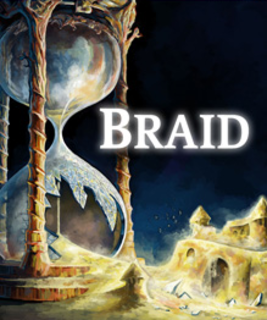Like all pieces of fine art Braid is beautiful on its surface and deep in its content
Braid can be interpreted as art as long as the player is willing to process the little tidbits of information the game throws on the screen. The game shows the adventures of Tim through a 2-D impressionist world of beautiful scenarios. His one goal is to find the princess, and in order to do so he faces challenges that mix platforming and puzzle solving to reach the castle at the end of each world. What may seem like an overused plot can gain an extremely deep meaning if only the player is willing to look hard enough for it.
The game may make a lot of references to titles that defined side-scrolling gameplay, but do not be deceived for Braid is an extremely original title. The game makes use of very clever time manipulating mechanics in order to build its puzzles. Tim has the amazing ability to rewind at will allowing players to recover from mistakes, start a stage all over again and much more. With a single press of a button you will watch the character undo all the actions you performed in order to go back to a certain point in time before a mistake or the falling into an endless pit happened.
There is a big catch though, the game has six different worlds all accessed through a hub house. In each one of these worlds a new time shifting mechanic will be introduced, this mechanic is only effective on the world it is presented and it can be used with Tim's rewinding ability – which is available on all the worlds – to solve the fun and highly challenging puzzles the game contains. By cracking the puzzle players will be awarded a puzzle piece. Your ultimate goal is to collect all of those pieces to find the princess.
The time-shifting mechanics are absolutely amazing. For example, in a world some glowing objects will be unaffected by rewind, which means while the entire stage goes back in time when players rewind the object will remain exactly where it is. Other abilities include a ring that makes nearby objects slower, advancing in time by walking to the right and going back by moving to the left and even creating a doppelganger that will precisely replicate the actions players performed before hitting rewind.
Aside from a few very cryptic optional textbooks before the beginning of each chapter the game doesn't give players much of an explanation on the time ability the character gains on each world. Instead the first stage of each world is a very simple puzzle exclusively used for players to learn the very basics on the new technique. Some gamers will end up easily frustrated by the discover for yourself nature of the game, but truth is the challenge encountered in discovering and expanding your knowledge on the newly acquired ability makes up for very rewarding results whenever you are able to solve one of the game's creative and tough puzzles.
The fact that Braid is a constantly changing experience due to the always different core time mechanics heavily benefit the title because by the end of each world, after solving all the riddles developers created based on a time-shifting ability, players will always urge for more. Braid never runs the risk of becoming a repetitive experience because each world's unique quirk is used up to a very comfortable point sitting between underused and repetitive. Instead of boring players out of their minds the game leaves you asking for more.
Visually the game looks like a beautiful and colorful watercolor painting and it stands as one of the best looking sidescrollers ever created, not only on an artistic level but also from a technical standpoint. The characters, enemies and landscapes seem to have been hand-drawn with amazing brush work and fantastic use of colors and the good animations just add to the visually impressive experience that is Braid.
The game suffers a little bit on its audio though. The game has an amazingly produced and rather nice set of songs that get repetitive fast due to their very short running time, despite the fact that some of them are very catchy tunes. The sound effects are extremely dull and generic and don't add a lot to the experience.
Like all puzzle games Braid suffers from lack of replay value. Gamers will spend somewhere between eight and fifteen hours with the game's main quest, depending on how good is their ability to think out of the box, use logic and easily adapt to the new challenges offered by each world. However, after solving all the puzzles there aren't many reasons to go back even though the game does make an effort in presenting seven tough-to-find stars that when collected will unlock a brand new ending sequence that is certainly a must for those trying to look past the game's find the princess tale.
In the end games, in general, do not qualify as art when the definition of the word is fully considered. Still, one or two diamonds in the rough can be found on an industry that produces so many games with each passing month. There is no question Braid qualifies as art. For those unable to see through the game's wonderful surface there is a shallow meaning to be found, and a rather cliché one, but gamers or, in this case, art admirers who look deep enough will find a message that is deeper and much more satisfying. And most importantly each and every one who digs deep enough will be able to reach a different conclusion and learn a unique lesson, after all that is the beauty of art.

